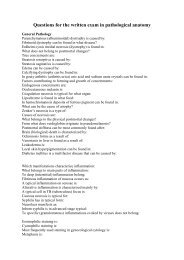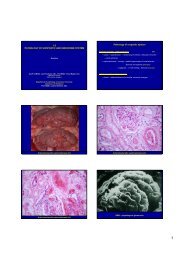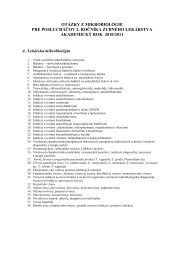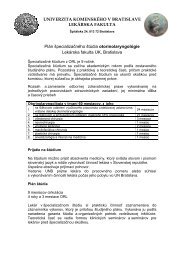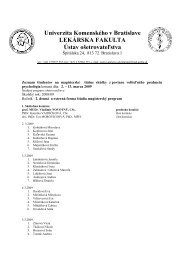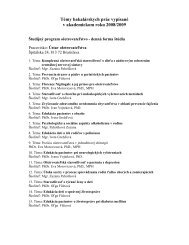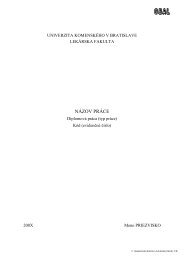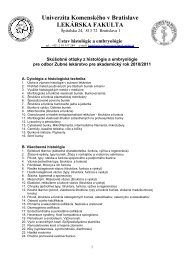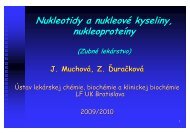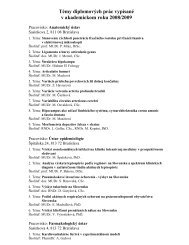- Page 1 and 2:
Štátny zdravotný ústav SR Slove
- Page 3 and 4:
OBSAH I. Ž IVOTNÉ PROSTREDIE A ZD
- Page 5 and 6:
III. ZDRAVOTNÁ BEZPEČ NOSŤ POTRA
- Page 7 and 8:
Ž P47 KUCHTA M., PETRÁŠOVÁ D.,
- Page 9 and 10:
Ž P71 ŠPLÍCHALOVÁ A., TOMÁŠKO
- Page 11 and 12:
Životné podmienky a zdravie, 2003
- Page 13 and 14:
škodlivin, z nichž nelze izolovan
- Page 15 and 16:
Kaž dý tento stupeň objektívneh
- Page 17 and 18:
Ľudia všeobecne pripisujú menš
- Page 19 and 20:
Ž ivotné podmienky a zdravie, 200
- Page 21 and 22:
period Mantel− Haenszel kde A ∑
- Page 23 and 24:
první publikované podezření poc
- Page 25 and 26:
VÝSLEDKY SYSTÉMU MONITOROVÁNÍ Z
- Page 27 and 28:
nepřesahuje 1 % limitu. Výpočet
- Page 29 and 30:
značnou individuální variabilitu
- Page 31 and 32:
V šesti městech (jedna třetina m
- Page 33 and 34:
Kritické parametry: fyzická aktiv
- Page 35 and 36:
Ž ivotné podmienky a zdravie, 200
- Page 37 and 38:
prů mě ru představovaly asi tře
- Page 39 and 40:
Ž ivotné podmienky a zdravie, 200
- Page 41 and 42:
Zá ver • Submikrónová frakcia
- Page 43 and 44:
Kontaminácia placenty Pb a výskyt
- Page 45 and 46:
Ž ivotné podmienky a zdravie, 200
- Page 47 and 48:
prachový ch častíc 10 µm alebo
- Page 49 and 50:
Ž ivotné podmienky a zdravie, 200
- Page 51 and 52:
Subjektívne sme posudzovali hlukov
- Page 53 and 54:
návrhu jednotnej päťstupňovej
- Page 55 and 56:
Ž ivotné podmienky a zdravie, 200
- Page 57 and 58:
Životné podmienky a zdravie, 2003
- Page 59 and 60:
Výsledky Poznajúc mechanizmus vý
- Page 61 and 62:
O - OUTWARD F - FLAT/ INDOOR / C -
- Page 63 and 64:
Výsledky monitoringu vybraných pa
- Page 65 and 66:
PRÍ RODNÉ KÚPALISKO ZEMPLÍ NSKA
- Page 67 and 68:
Tab.1. Cyanotoxíny a ich akútna t
- Page 69 and 70:
mg/l 0,12 0,1 0,08 0,06 0,04 0,02 B
- Page 71 and 72:
Ž ivotné podmienky a zdravie, 200
- Page 73 and 74:
potrebné brať do úvahy, že prá
- Page 75 and 76:
postoje k těmto rizikům a konečn
- Page 77 and 78:
dochází k jejich kumulaci. Naše
- Page 79 and 80:
Je to především otázka aplikace
- Page 81 and 82:
a tvári). Pri dlhoročnej chronick
- Page 83 and 84:
zachrípnutie, vysychanie hrdla, d
- Page 85 and 86:
vzniku metylortuti, zachytá vanou
- Page 87 and 88:
Tab. 2. Anamnestické údaje zisten
- Page 89 and 90:
Ž ivotné podmienky a zdravie, 200
- Page 91 and 92:
Ž ivotné podmienky a zdravie, 200
- Page 93 and 94:
Tab. 5. Mikrobiologické vlastnosti
- Page 95 and 96:
Ž ivotné podmienky a zdravie, 200
- Page 97 and 98:
prípadov. Podozrenie na chorobu z
- Page 99 and 100:
mononeuropatia hornej konč atiny (
- Page 101 and 102:
Ž ivotné podmienky a zdravie, 200
- Page 103 and 104:
eprezentativní skupinu PAU. Jako p
- Page 105 and 106:
a exkrecí 1-OHP v různých prost
- Page 107 and 108:
24. Fiala, Z., Vyskocil, A., Krajá
- Page 109 and 110:
exponovaná a jedna kontrolná skup
- Page 111 and 112:
Pri porovnaní vý sledkov exponova
- Page 113 and 114:
• mutačné zmeny GM, teda ich ak
- Page 115 and 116:
Ž ivotné podmienky a zdravie, 200
- Page 117 and 118:
aj pre farbivá zásada sprá vnej
- Page 119 and 120:
Ž ivotné podmienky a zdravie, 200
- Page 121 and 122:
nenasýtených mastných kyselín s
- Page 123 and 124:
Z tabulky 1 je zřejmé, že výži
- Page 125 and 126:
Obr. 4 ukazuje obdobný jídelníč
- Page 127 and 128:
Tab. 4. Složenívýrobků z hledis
- Page 129 and 130:
HO o OH HO HOOC OH HO o OH o o Nena
- Page 131 and 132:
• oxidá cia lipoproteínov - vzn
- Page 133 and 134:
hydroxyperoxidov. Zatiaľ čo v skl
- Page 135 and 136:
obsahem tuku, zejména suš enky s
- Page 137 and 138:
Obsah polyenových mastných kyseli
- Page 139 and 140:
veľmi slabú absorpciu. Stabilitu
- Page 141 and 142:
Ž ivotné podmienky a zdravie, 200
- Page 143 and 144:
V logaritmickej fáze, kedy sa bakt
- Page 145 and 146:
5. Granum, P. E., Tomas, J. M., Alo
- Page 147 and 148:
Matematické spracovanie vý sledko
- Page 149 and 150:
5. Valík, Ľ., Lauková , D., Gör
- Page 151 and 152:
Imunofarmakologické vlastnosti Ple
- Page 153 and 154:
100% 80% 60% 40% 20% 0% 1977-1986 1
- Page 155 and 156:
v analý ze systematicky zozbieran
- Page 157 and 158:
ucha, v jednom prípade aj zvracani
- Page 159 and 160:
Ž ivotné podmienky a zdravie, 200
- Page 161 and 162:
V predkladanej prá ci kvô li vyl
- Page 163 and 164:
HODNOTENIE VÝŽIVOVEJ SPOTREBY A R
- Page 165 and 166:
cholesterol vit. C vit. E energia b
- Page 167 and 168:
8. Rimárová, K., Bernasovská, K.
- Page 169 and 170:
sporadická, ale hodnota jó du v n
- Page 171 and 172:
Ž ivotné podmienky a zdravie, 200
- Page 173 and 174:
Tab. 2. Hladiny homocysteínu, vita
- Page 175 and 176:
chorôb, spôsobených atakom reakt
- Page 177 and 178:
Ž ivotné podmienky a zdravie, 200
- Page 179 and 180:
Ak hovoríme o prevencii civilizač
- Page 181 and 182:
V poradnách dostalo informace o š
- Page 183 and 184:
60% žen, ale uposlechlo jen méně
- Page 185 and 186:
Pro první kontakt s respondenty by
- Page 187 and 188:
80 70 68,4 60 60 55,1 50 50 procent
- Page 189 and 190:
Všem vyšetřovaným potravinovým
- Page 191 and 192:
výsledku můž e zasáhnout také
- Page 193 and 194:
přijímané stravy (3). Ve studii
- Page 195 and 196:
Ze sledovaný ch mikronutrientů by
- Page 197 and 198:
Ž ivotné podmienky a zdravie, 200
- Page 199 and 200:
Hladiny nitrá tov Zo 69 vzoriek pi
- Page 201 and 202:
Zo sociá lnych faktorov má na dia
- Page 203 and 204:
Deti v rodiná ch matiek a otcov s
- Page 205 and 206:
Životné podmienky a zdravie, 2003
- Page 207 and 208:
iziká podávania probiotík, ktor
- Page 209 and 210:
3. 4. 5. 6. 7. 8. 9. 10. 11. 12. 13
- Page 211 and 212:
V ďalšom uvá dzame výsledky, z
- Page 213 and 214:
Ž ivotné podmienky a zdravie, 200
- Page 215 and 216:
vegánov - 0,188, v porovnaní s la
- Page 217 and 218:
Hodnoty ceruloplazmínu (Cp) a tran
- Page 219 and 220:
Životné podmienky a zdravie, 2003
- Page 221 and 222:
Výsledky ukázali, že školáci s
- Page 223 and 224:
Záver Možno zhodnotiť, že pohyb
- Page 225 and 226:
Ž ivotné podmienky a zdravie, 200
- Page 227 and 228:
Životné podmienky a zdravie, 2003
- Page 229 and 230:
ostatní (lavička, traverza, strom
- Page 231 and 232:
Životné podmienky a zdravie, 2003
- Page 233 and 234:
kvalita komunikací a dopravních o
- Page 235 and 236:
prostředí, ve kterém se děti po
- Page 237 and 238:
Incidencia ú razov u chlapcov vo v
- Page 239 and 240: končatín (3,8/10000 muž ov a 4,0
- Page 241 and 242: Ž ivotné podmienky a zdravie, 200
- Page 243 and 244: ná lezy, týkajúce sa zdravotnýc
- Page 245 and 246: Tab. 2. Kolik času denně tráví
- Page 247 and 248: Tab. 6. Proč jsi užil drogu % ž
- Page 249 and 250: • Nedostatečný přísun tekutin
- Page 251 and 252: Avšak, aká je realita fajčiarsky
- Page 253 and 254: Na obr. 3 sú zobrazené výdavky n
- Page 255 and 256: kampaň, USA - celospoločenské ka
- Page 257 and 258: epublice a jejich aplikace na praco
- Page 259 and 260: Výsledky Uvádíme některé údaj
- Page 261 and 262: Životné podmienky a zdravie, 2003
- Page 263 and 264: K první cigaretě přistupovala v
- Page 265 and 266: Respondenti byli vyzváni, aby pomo
- Page 267 and 268: dosud nelegálních drog, je poklá
- Page 269 and 270: Obr. 2: Výživa dětí po narozen
- Page 271 and 272: vyšší vnitřní dávku respirabi
- Page 273 and 274: prechodné obdobia vo vývoji spolo
- Page 275 and 276: Životné podmienky a zdravie, 2003
- Page 277 and 278: Bydlisko Doma Mimo 0 10 20 30 40 50
- Page 279 and 280: (7). V našom súbore je zo sledova
- Page 281 and 282: 3. Dohnal, K., Benešová, V.: Kou
- Page 283 and 284: telesnou hmotnosťou aj vyšší tl
- Page 285 and 286: cielene zlepš ovať jej vzdelávan
- Page 287 and 288: Čo sa týka TCH, v skupine dievča
- Page 289: telesnej hmotnosti, krvného tlaku,
- Page 293 and 294: ketoglutarate complex (including th
- Page 295 and 296: indirect energometric point at two
- Page 297 and 298: Životné podmienky a zdravie, 2003
- Page 299 and 300: glukóza (mmol/l) 8 7 6 5 4 3 r=0,5
- Page 301 and 302: Životné podmienky a zdravie, 2003
- Page 303 and 304: telesne pracujúci. Muži sa dvojn
- Page 305 and 306: všetky sledované parametre s výn
- Page 307 and 308: CRF 8 7,8 7,6 7,4 7,2 7 6,8 6,6 6,4
- Page 309 and 310: Ž ivotné podmienky a zdravie, 200
- Page 311 and 312: koncentráciu apo C-II a apo C-III.
- Page 313 and 314: zdatnosti (12). Pohybová aktivita
- Page 315 and 316: Porovná ní vý sledků jednotliv
- Page 317 and 318: 7. Kříž, J. a kol.: Jak jsme na
- Page 319 and 320: asociaci k věku - čím byli lidé
- Page 321 and 322: ekonomicky aktivních (p
- Page 323 and 324: 5krát častěji v psychické nepoh
- Page 325 and 326: výsledkem změny přístupu k vlas
- Page 327 and 328: Životné podmienky a zdravie, 2003
- Page 329 and 330: ací byli o polovinu méně pasivn
- Page 331 and 332: Tab. 4. Nespokojenost ve vztahu k S
- Page 333 and 334: statek psychické pohody. Podle lit
- Page 335 and 336: 12. Koenig, H. G.: Religious attitu
- Page 337 and 338: měl zvýšit návratnost, jiní au
- Page 339 and 340: Analýza dat následovala po získ
- Page 341 and 342:
Stejný postup byl zvolen i v pří
- Page 343 and 344:
500 400 300 383 Spokojenost Počet
- Page 345 and 346:
Ž ivotné podmienky a zdravie, 200
- Page 347 and 348:
v prípade kaliperického merania.
- Page 349 and 350:
teda pre celú dospelú populáciu
- Page 351 and 352:
Ž ivotné podmienky a zdravie, 200
- Page 353 and 354:
vitamín C, aby sa umožnila oprava
- Page 355 and 356:
12. The Alpha-Tocopherol, Beta-Caro
- Page 357 and 358:
Reavenův metabolický syndrom X je
- Page 359 and 360:
Ž ivotné podmienky a zdravie, 200
- Page 361 and 362:
predpokladať, že pôsobiace sily
- Page 363 and 364:
andomizovanej, dvojito slepej štú
- Page 365 and 366:
Životné podmienky a zdravie, 2003
- Page 367 and 368:
ktorý by skóroval plným počtom
- Page 369 and 370:
Životné podmienky a zdravie, 2003
- Page 371 and 372:
alebo iných formách zlého zaobch
- Page 373 and 374:
Ž ivotné podmienky a zdravie, 200
- Page 375 and 376:
Ž ivotné podmienky a zdravie, 200
- Page 377 and 378:
- prístroje na meranie chemických
- Page 379 and 380:
publiká ciá ch v zborníku, ktor
- Page 381 and 382:
Rok 2002 pre ná s - obyvateľ ov t
- Page 383 and 384:
Fridrich J. 78 G Gajdoš A. 106 Gaj
- Page 385 and 386:
Petrášová D. 195, 203, 208, 214,



